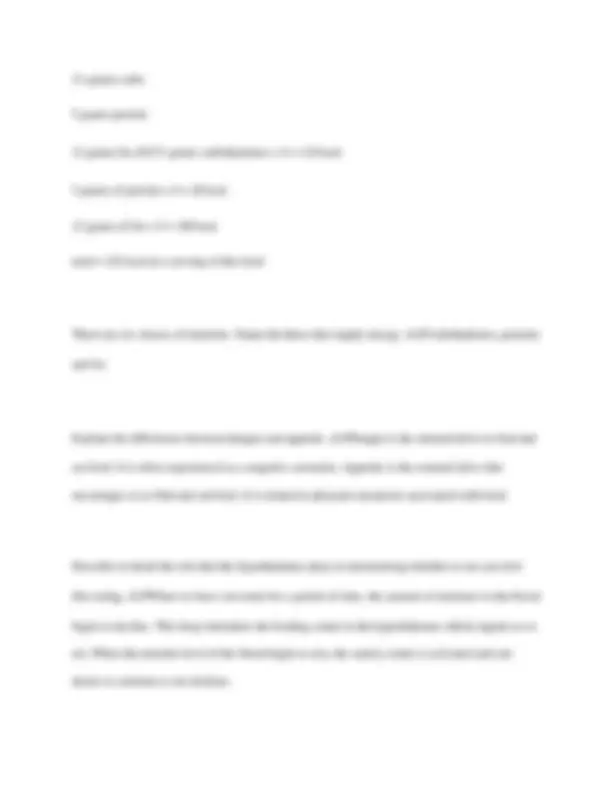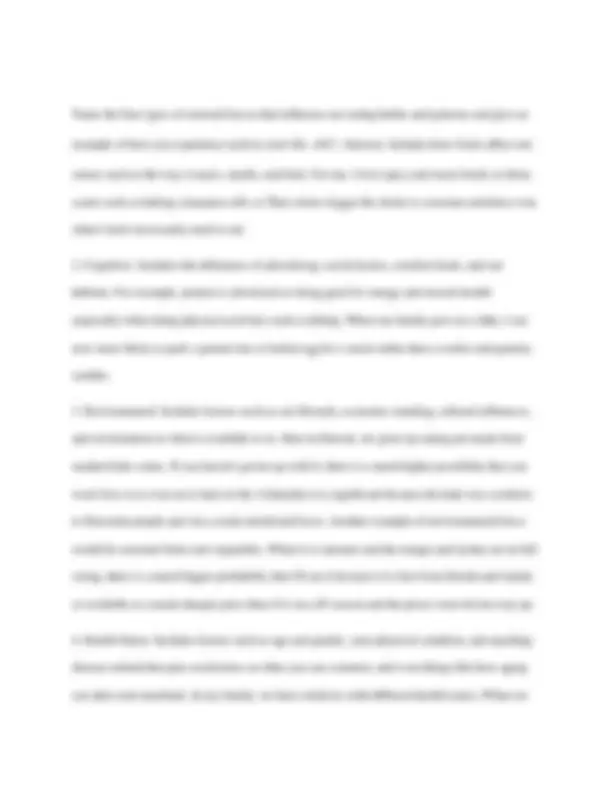





Study with the several resources on Docsity

Earn points by helping other students or get them with a premium plan


Prepare for your exams
Study with the several resources on Docsity

Earn points to download
Earn points by helping other students or get them with a premium plan
Community
Ask the community for help and clear up your study doubts
Discover the best universities in your country according to Docsity users
Free resources
Download our free guides on studying techniques, anxiety management strategies, and thesis advice from Docsity tutors
A series of questions and answers related to nutrition and metabolism, covering topics such as calorie calculation, macronutrients, hunger and appetite, and the role of hormones in regulating food intake. It provides practical examples and explanations to enhance understanding of these concepts.
Typology: Exams
1 / 7

This page cannot be seen from the preview
Don't miss anything!




If a fudge brownie has 9 grams of carbohydrates, 1 gram of protein and 12 grams of fat. How
many calories are in the brownie? ✔✔9 grams of carbohydrates x 4 = 36 kcal
1 gram of protein x 4 = 4 kcal
12 grams of fat x 9 = 108 kcal
total = 148 kcal
If you ate the fudge brownie, you would consume 148 calories.
If a fudge brownie has 22 grams of carbohydrates, 2 gram of protein and 16 grams of fat. How
many calories are in the brownie? ✔✔22 grams carbohydrates x 4 = 88 kcal
2 grams protein x 4 = 8 kcal
16 grams fat x 9 = 144 kcal
total = 240 kcal
If you ate the fudge brownie, you would consume 240 calories.
If a fudge brownie has 12 grams of carbohydrates, 2 grams of protein and 10 grams of fat. How
many calories are in the brownie? ✔✔2 grams protein x 4 = 8 kcal
10 grams fat x 9 = 90 kcal
total = 146 kcal
If you ate the fudge brownie, you would consume 146 calories.
The current recommendation to maintain your body weight is 2000 calories daily. If you are told that you should not consume any more than 23 % of your calories from fat, how many grams of
fat should you eat in a day? ✔✔2000 x .23 = 460460 calories / 9 = 51.1 grams of fat
An individual's health can be assessed using the ABCDE's of nutritional assessment. Below,
indicate what each letter represents. ✔✔A - Athropometrics- measurements of body composition
such as height and weight
B - Biochemical- measurement of nutrients in blood, urine and feces
C - Clinical - physical exam and general appearance
D - Dietary- review of dietary intake and assessment
E - Environmental- background, family history, life style and living conditions
31 grams carbs
5 grams protein
12 grams fat ✔✔31 grams carbohydrates x 4 = 124 kcal
5 grams of protein x 4 = 20 kcal
12 grams of fat x 9 = 108 kcal
total = 252 kcal in a serving of this food
There are six classes of nutrients. Name the three that supply energy. ✔✔Carbohydrates, proteins
and fat
Explain the differences between hunger and appetite. ✔✔Hunger is the internal drive to find and
eat food. It is often experienced as a negative sensation. Appetite is the external drive that encourages us to find and eat food. It is related to pleasant sensations associated with food.
Describe in detail the role that the hypothalamus plays in determining whether or not you feel
like eating. ✔✔When we have not eaten for a period of time, the amount of nutrients in the blood
begin to decline. This drop stimulates the feeding center in the hypothalamus which signals us to eat. When the nutrient level of the blood begin to rise, the satiety center is activated and our desire to continue to eat declines.
Name the four types of external forces that influence our eating habits and patterns and give an
example of how you experience each in your life. ✔✔1. Sensory: Includes how foods affect our
senses such as the way it tastes, smells, and feels. For me, I love spicy and sweet foods so those scents such as baking cinnamon rolls or Thai curries trigger the desire to consume nutrients even when I don't necessarily need to eat.
Under-nutrition occurs when nutrient intake does not meet nutrient needs and over time health begins to decline.
Given the nutritional label shown below, how many milligrams of sodium will you consume if you ate the entire container of macaroni and cheese?
470 ml per serving
there are 2 servings in a box ✔✔470 mg per serving x 2 servings per container = 940 mg
Name the key hormone that causes a feeling of satiety. Indicate where in the body it is produced
and the process by which it operates. ✔✔Leptin is produced by the fat cells which are also
known as adipose tissue. The role of leptin is to alert the brain to turn off the hunger center and activate the satiety center when consuming a meal.